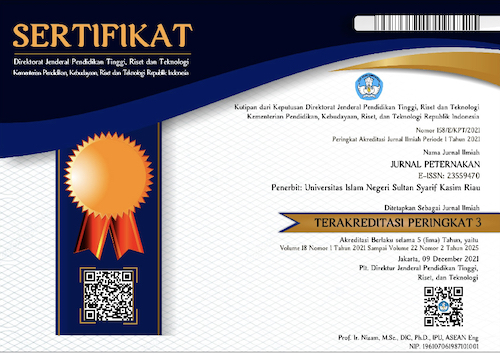Effect of Various Types of Sugars on Antioxidant Activity and Physico-chemical Properties of Kombucha Fermented Whey
Abstract
Keywords
Full Text:
PDFReferences
Al-Kalifawi, E., & Hassan, I. A. (2014). Factors Influence on the yield of Bacterial Cellulose of Kombucha (Khubdat Humza). Baghdad Science Journal, 11(3), 1420–1428. https://doi.org/10.21123/bsj.11.3.1420-1428.
AMS, USDA. (2015). Whey Protein Concentrate (WPC) Handling. USDA, AMS, Agricultural Analytics Division for the USDA National Organic Program, 1–18.
Asghar, M. T., Yusof, Y. A., Mokhtar, M. N., Ya’acob, M. E., Mohd. Ghazali, H., Chang, L. S., & Manaf, Y. N. (2020). Coconut (Cocos nucifera L.) sap as a potential source of sugar: Antioxidant and nutritional properties. Food Science and Nutrition, 8(4), 1777–1787. https://doi.org/10.1002/fsn3.1191.
Bishop, P., Pitts, E. R., Budner, D., & Thompson-Witrick, K. A. (2022). Chemical Composition of Kombucha. Beverages, 8(3), 1–17. https://doi.org/10.3390/beverages8030045.
Chandan, R. C. (2006). History and Consumption Trends. In R. C. Chandan, C. H. White, A. Kilara, & Y. H. Hui (Eds.), Manufacturing Yogurt and Fermented Milks (First edit, pp. 3–16). Blackwell Publishing.
Daji, G. A., Green, E., Abrahams, A., Oyedeji, A. B., Masenya, K., Kondiah, K., & Adebo, O. A. (2022). Physicochemical Properties and Bacterial Community Profiling of Optimal Mahewu (A Fermented Food Product) Prepared Using White and Yellow Maize with Different Inocula. Foods, 11(20), 1–14. https://doi.org/10.3390/foods11203171.
Frye, C. P. (2013). Regulations for Product Standards and Labeling. In R. C. Chandan, C. H. White, A. Kilara, & Y. H. Hui (Eds.), Manufacturing Yogurt and Fermented Milks, Second Edition (first edit, pp. 71–93). https://doi.org/10.1002/9781118481301.ch4.
Fu, C., Yan, F., Cao, Z., Xie, F., & Lin, J. (2014). Antioxidant activities of kombucha prepared from three different substrates and changes in content of probiotics during storage. 2013(006227), 123–126.
Hadiwiyoto. (1994). Pengujian Mutu Susu dan Hasil Olahannya. Liberty.
Hrnjez, D., Vaštag, Milanović, S., Vukić, V., Iličić, M., Popović, L., & Kanurić, K. (2014). The biological activity of fermented dairy products obtained by kombucha and conventional starter cultures during storage. Journal of Functional Foods, 10(2014), 336–345. https://doi.org/10.1016/j.jff.2014.06.016.
Ivanišová, E., Meňhartová, K., Terentjeva, M., Harangozo, Ľ., Kántor, A., & Kačániová, M. (2020). The evaluation of chemical, antioxidant, antimicrobial and sensory properties of kombucha tea beverage. Journal of Food Science and Technology, 57(5), 1840–1846. https://doi.org/10.1007/s13197-019-04217-3.
Khan, I. T., Nadeem, M., Imran, M., Ullah, R., Ajmal, M., & Jaspal, M. H. (2019). Antioxidant properties of Milk and dairy products: a comprehensive review of the current knowledge. Lipid in Health and Disease, 18(41), 1–13. https://doi.org/https://doi.org/10.1186/s12944-019-0969-8 (2019).
Kluz, M. I., Pietrzyk, K., Pastuszczak, M., Kacaniova, M., Kita, A., Kapusta, I., Zaguła, G., Zagrobelna, E., Struś, K., Marciniak-Lukasiak, K., Stanek-Tarkowska, J., Timar, A. V., & Puchalski, C. (2022). Microbiological and Physicochemical Composition of Various Types of Homemade Kombucha Beverages Using Alternative Kinds of Sugars. Foods, 11(10), 1–15. https://doi.org/10.3390/FOODS11101523.
Kruk, M., Trząskowska, M., Ścibisz, I., & Pokorski, P. (2021). Application of the “scoby” and kombucha tea for the production of fermented milk drinks. Microorganisms, 9(1), 1–17. https://doi.org/10.3390/microorganisms9010123.
Kumar, V., & Joshi, V. K. (2016). Kombucha : Technology, Microbiology, Production, Composition and Therapeutic Value . International Journal of Food and Fermentation Technology, 6(1), 13. https://doi.org/10.5958/2277-9396.2016.00022.2.
Laureys, D., Britton, S. J., & De Clippeleer, J. (2020). Kombucha Tea Fermentation: A Review. Journal of the American Society of Brewing Chemists, 78(3), 165–174. https://doi.org/10.1080/03610470.2020.1734150.
Lekjing, S., Keawpeng, I., Venkatachalam, K., & Karrila, S. (2022). Impact of Different Sugar Types and Their Concentrations on Salted Duck Egg White Based Meringues. Foods, 11(9), 1–15. https://doi.org/10.3390/foods11091248.
Liu, C. H., Hsu, W. H., Lee, F. L., & Liao, C. C. (1996). The isolation and identification of microbes from a fermented tea beverage, Haipao, and their interactions during Haipao fermentation. Food Microbiol, 13, 407–415.
Maryani, Y., Rochmat, A., Khastini, R. O., Kurniawan, T., & Saraswati, I. (2021). Identification of Macro Elements (Sucrose, Glucose and Fructose) and Micro Elements (Metal Minerals) in the Products of Palm Sugar, Coconut Sugar and Sugar Cane. Joint Proceedings of the 2nd and the 3rd International Conference on Food Security Innovation (ICFSI 2018-2019), 9, 271–274. https://doi.org/10.2991/absr.k.210304.051.
Muhialdin, B. J., Osman, F. A., Muhamad, R., Wan Sapawi, C. W. N. S. C., Anzian, A., Voon, W. W. Y., & Hussin, A. S. M. (2019a). Effects of sugar sources and fermentation time on the properties of tea fungus (kombucha) beverage. International Food Research Journal, 26(2), 481–487. http://ifrj.upm.edu.my/26 (02) 2019/(13).pdf
Muhialdin, B. J., Osman, F. A., Muhamad, R., Wan Sapawi, C. W. N. S. C., Anzian, A., Voon, W. W. Y., & Hussin, A. S. M. (2019b). Effects of sugar sources and fermentation time on the properties of tea fungus (kombucha) beverage. International Food Research Journal, 26(2), 481–487.
Neffe-Skocińska, K., Sionek, B., Ścibisz, I., & Kołożyn-Krajewska, D. (2017). Contenido de ácido y efectos de las condiciones de fermentación en las propiedades fisicoquímicas, microbiológicas y sensoriales de bebidas de té de Kombucha. CYTA - Journal of Food, 15(4), 601–607. https://doi.org/10.1080/19476337.2017.1321588.
Nurliyani, Indratiningsih, Widodo, Sukarno, A. S., & Suciati, F. (2019). Characteristics of fermented goat milk using combination of kombucha and Lactobacillus casei starters. IOP Conference Series: Earth and Environmental Science, 387(1). https://doi.org/10.1088/1755-1315/387/1/012077.
Osiripun, V., & Apisittiwong, T. (2021). Polyphenol and antioxidant activities of Kombucha fermented from different teas and fruit juices. Journal of Current Science and Technology, 11(2), 188–196. https://doi.org/10.14456/jcst.2021.20.
Özyurt, V. H. (2020). Changes in the content of total polyphenols and the antioxidant activity of different beverages obtained by Kombucha ‘tea fungus.’ International Journal of Agriculture Environment and Food Sciences, 4(3), 255–261. https://doi.org/10.31015/jaefs.2020.3.3.
Sadler, G. D., & Murphy, P. A. (2010). pH and Titratable Acidity. In Food Analysis. Springer US. https://doi.org/https://doi.org/10.1007/978-1-4419-1478-1_13.
Sinamo, K. N., Ginting, S., & Pratama, S. (2022). Effect of sugar concentration and fermentation time on secang kombucha drink. IOP Conference Series: Earth and Environmental Science, 977(1). https://doi.org/10.1088/1755-1315/977/1/012080.
Sitanggang, F. A., & Machfoedz, M. M. (2023). Proceedings of the 2nd International Conference for Smart Agriculture, Food, and Environment (ICSAFE 2021). In Proceedings of the 2nd International Conference for Smart Agriculture, Food, and Environment (ICSAFE 2021). Atlantis Press International BV. https://doi.org/10.2991/978-94-6463-090-9.
Srihari, T., & Satyanarayana, U. (2012). Changes in free radical scavenging acivity of kombucha during fermentation. J. Pharm. Sci & Res, 4, 1978–1981.
Srikaeo, K., & Thongta, R. (2015). Effects of sugarcane, palm sugar, coconut sugar and sorbitol on starch digestibility and physicochemical properties of wheat based foods. International Food Research Journal, 22(3), 923–929.
Suciati, F., Nurliyani, N., & Indratiningsih, I. (2019). Physicochemical, Microbiological and Sensory Properties of Fermented Whey using Kombucha Inoculum. Buletin Peternakan, 43(1), 52–57. https://doi.org/10.21059/buletinpeternak.v43i1.31496.
Sudarmadji, S., & Haryono, B. (1997). Analisa Bahan Makanan dan Pertanian. Liberty Yogyakarta.
Villarreal-Soto, S. A., Beaufort, S., Bouajila, J., Souchard, J.-P., & Taillandier, P. (2018). Understanding Kombucha Tea Fermentation: A Review. Journal of Food Science, 83(3), 580–588. https://doi.org/https://doi.org/10.1111/1750-3841.14068.
Villarreal-Soto, S. A., Beaufort, S., Bouajila, J., Souchard, J. P., Renard, T., Rollan, S., & Taillandier, P. (2019). Impact of fermentation conditions on the production of bioactive compounds with anticancer, anti-inflammatory and antioxidant properties in kombucha tea extracts. Process Biochemistry, 83(May), 44–54. https://doi.org/10.1016/j.procbio.2019.05.004.
Vitas, J. S., Malbaša, R. V, Grahovac, J. A., & Lončar, E. S. (2013). The Antioxidant Activity of Kombucha Fermented Milk Products with Stinging Nettle and Winter Savory. Chemical Industry and Chemical Engineering Quarterly, 19(1), 129–139. https://doi.org/10.2298/CICEQ120205048V.
Zubaidah, E., Ifadah, R. A., & Afgani, C. A. (2019). Changes in chemichal characteristics of kombucha from various cultivars of snake fruit during fermentation. IOP Conference Series: Earth and Environmental Science, 230(1). https://doi.org/10.1088/1755-1315/230/1/012098.
DOI: http://dx.doi.org/10.24014/jupet.v21i1.28313
Refbacks
- There are currently no refbacks.
Jurnal Peternakan has been accredited by Sinta 3 : Number 158/E/KPT/2021
Starting from Vol. 18 No. 1 Year 2021 to Vol. 22 No. 2 Year 2025
Jurnal Peternakan Indexed By:
Editorial Office:
Jurnal Peternakan
Faculty of Agriculture and Animal Science, State Islamic University of Sultan Syarif Kasim Riau.
H.R. Soebrantas street KM. 15,5 Panam – Pekanbaru city.
E-mail: jurnal.peternakan@uin-suska.ac.id
ejournal: http://ejournal.uin-suska.ac.id/index.php/peternakan

Creation is distributed under the Creative Commons Attribution 4.0 International License. View Mystats















